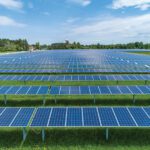For some utilities, community solar is a way to offer consumers access to clean energy without requiring investment in rooftop solar. For others, it presents a means of strategically placing solar resources in the most beneficial locations. Meanwhile, many utilities view it as an opportunity to learn how best to integrate distributed energy resources (DERs). Regardless of motivation, community and cooperative solar projects are skyrocketing—particularly at rural electric cooperatives, where solar capacity has shot up from 35 MW of capacity in 2010 to nearly 900 MW by the end of 2017.
According to the National Renewable Energy Lab (NREL), 50% of rooftops are inappropriate for solar systems due to a long list of possible reasons. Community solar programs offer participants access to energy produced by one, larger-scale, centrally located solar array, without the cost of installing a rooftop system. For utilities, the benefits of installing and managing a community solar project include greater control over the planning, monitoring, and load-balancing functions necessary to maintain consistent power quality.
One challenge most cooperatives have overcome involves funding. As non-profit organizations, they don’t qualify for federal tax credits. For that reason, it’s usually a third party that builds the installation and gives the utility discounted electricity that reflects tax credits, a savings the utility can pass along to consumers.
The community model has emerged to expand access to clean energy as consumer interest has increased and the cost of installed solar has declined. As of July 2018, nearly a quarter of all co-ops offer a total of 196 existing community solar programs, according to the National Rural Electric Cooperative Association (NRECA) report, “A Solar Revolution in Rural America.”
“Electric cooperatives are led by and belong to the communities that they serve. This heightened community focus allows co-ops to quickly adapt to evolving consumer expectations,” NRECA CEO Jim Matheson said. “As solar costs come down, co-ops are bringing the benefits of this renewable resource to local communities and consumer-members across the country, often in places once written off as unsuitable for solar.”
Middle Tennessee Electric Membership Corp., one of the fastest growing cooperative utilities in the country, built a 1-MW solar farm on property located in a flood zone, rendering it unsuitable for other kinds of development. Cooperative members were quick to sign up for the opportunity to lease panels. Whatever energy is generated from those leases then goes back on the members’ bill as a credit.
Outside of being member-owned organizations, electric cooperatives also have fewer regulatory hurdles to contend with, and they can more quickly test and implement technologies necessary for the successful integration of DERs. In the case of Middle Tennessee, the utility has deployed advanced metering and IoT network technology that connects sensors and distribution devices to support the voltage management necessary on the solar-powered circuit. It also plans to augment its solar program with battery storage.
Key benefits offered by DERs—clean electrification, increased consumer choice, and the potential for enhanced reliability—align well with the energy trends that we are witnessing today, and models like community solar will likely expand in the years to come as our distributed energy future continues to develop.
—Andy Marshall is practice director of Distributed Energy Resource Management at Landis+Gyr, an energy management solutions provider.










